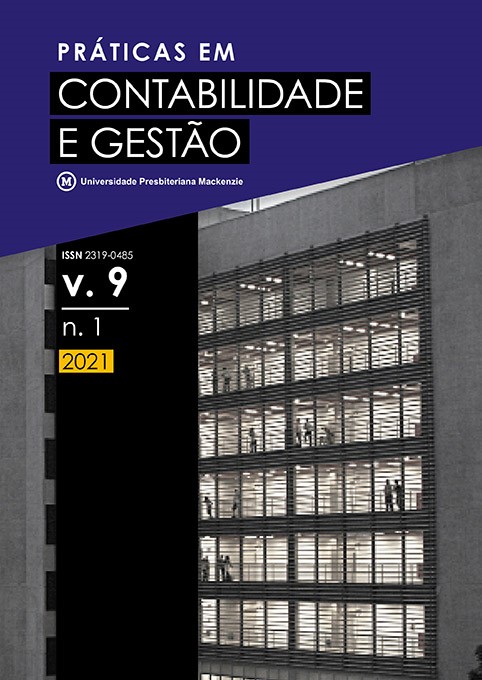Expected Loss Model Adoption Analysis According to CPC 48: Financial Instruments by Energy Distributors of Southeast Brazil
Keywords:
Financial Instruments, CPC 48, Impairment, Energy DistributorsAbstract
The objective of this study was to verify if there is a significant difference in the calculation of Estimated Losses with Doubtful Accounts (PECLD) by the incurred losses method, according to CPC 38, and by the expected losses method, according to CPC 48 in the southeast power distributors. of Brazil. With a sample of 10 entities regulated by CVM and ANEEL for the analyzed sector, the accounting information of the December 2017 Explanatory Notes was used for the impairment calculated in accordance with CPC 38 and the ITR of March 2018, for impairment of December 2017 recalculated in accordance with CPC 48. The changes introduced by CPC 48 produced significant changes in the balance of Customers meeting the IASB's initial objective of changing the impairment calculation of financial assets in response to problems encountered in the 2008 global financial crisis, significantly higher than the one calculated by the loss incurred method, impacting the balance sheet of the electricity distributors of southeastern Brazil. This study contributes to research on agency theory, favoring a reduction of informational asymmetry between internal and external users.Downloads
References
Agência Nacional de Energia Elétrica (Aneel) (2018). Distribuidoras da região Sudeste. Recuperado
de http://www.aneel.gov.br/distribuidoras-regiao-sudeste
Comitê de Pronunciamentos Contábeis (CPC) (2016). CPC 48: Instrumentos Financeiros. Recuperado
de http://static.cpc.aatb.com.br/Documentos/530_CPC_48.pdf
Dantas, J. A., Micheletto, M. A., Cardoso, F. A., & De Sá, A. A. P. F. (2017). Perdas em crédito
nos bancos brasileiros: Modelos de perdas esperadas e de perdas incorridas e impactos da
IFRS 9. Revista de Gestão, Finanças e Contabilidade, 7(2), 156-175.
Ferreira, M. N. (2016). Imparidade e PCLD: Análise de convergência entre a IFRS 9 e a resolução
682/99 como argumento para pleitear, junto ao Banco Central, um ajuste na norma
nacional (dissertação de mestrado). Universidade Presbiteriana Mackenzie, São Paulo,
São Paulo.
Grant Thornton (2017). Qual o impacto da IFRS 9? Recuperado de https://www.grantthornton.
com.br/insights/articles-and-publications/ifrs-92/
Gomes, A. (2015). Entrevista pessoal por Maristela Girotto. Revista Brasileira de Contabilidade,
Gornjak, M. (2017). Comparison of IAS 39 and IFRS 9: The analysis of replacement. International
Journal of Management, Knowledge and Learning, 1, 115-130.
Malaquias, R. F. (2008). Disclosure de instrumentos financeiros segundo as normas internacionais
de contabilidade: Evidências empíricas de empresas brasileiras (dissertação de mestrado).
Universidade Federal de Uberlândia, Uberlândia.
Martins, G. A., & Theóphilo, C. R. (2007). Metodologia da investigação científica para ciências
sociais aplicadas. São Paulo: Atlas.
Niyama, J. K., & Silva, C. A. T. Teoria da Contabilidade (2a. ed.). São Paulo: Ed. Atlas, 2011.
Nunes, P. V. M. N. (2016). Imparidade e PCLD de ativos financeiros: O impacto institucional do
IFRS (dissertação de mestrado). Pontifícia Universidade Católica de São Paulo, São Paulo.
Pelucio-Grecco, M. C., Geron, C. M. S., Grecco, G. B., & Lima, J. P. C. (2014). The effect of
IFRS on earnings management in Brazilian non-financial public companies. Emerging
Markets Review, 21, 42-66.
Pucci, R., & Skærbæk, P. (2020). The co-performation of financial economics in accounting
standard-setting: A study of the translation of the expected credit loss model in IFRS 9.
Accounting, Organizations and Society, 81, 101076.
Sánchez Serrano, A. (2018). Financial stability consequences of the expected credit loss model
in IFRS 9. Financial Stability Review, issue 34 (May 2018), 77-95.
Seitz, B., Dinh, T., & Rathgeber, A. (2018). Understanding loan loss reserves under IFRS 9: A
simulation-based approach. Advances in Quantitative Analysis of Finance and Accounting,
, 311-357.
Silva, C. A. M. (2014). Efeito da aplicação dos conceitos de perda esperada e perda incorrida na
estimativa de redução ao valor recuperável (trabalho de conclusão de curso). Universidade
de Brasília, Brasília.
Soreira, A. (2018). Mudanças geradas pela IFRS 9 e operacionalização do provisionamento de
perdas de crédito esperadas (dissertação de mestrado). Universidade de São Paulo, São
Paulo. doi:10.11606/D.12.2018.tde-16042018-160301




